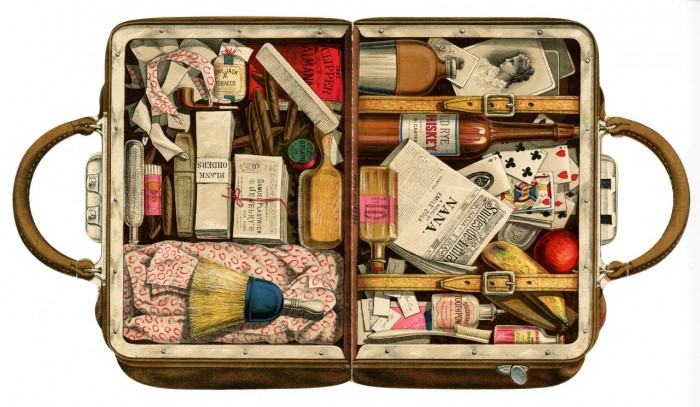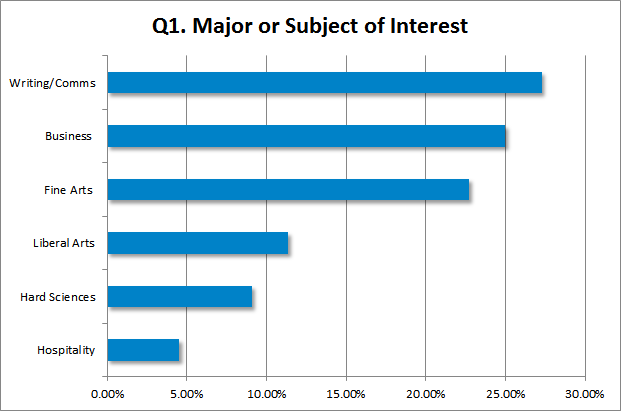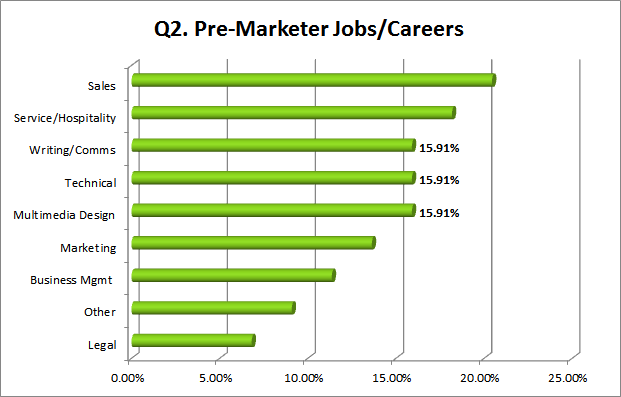The path to becoming a marketer is often circuitous, wending its way through career stints, starts and stops. For example:
 “I was a graphic designer for a newspaper.”
“I was a graphic designer for a newspaper.”
“I was a dancer and actor in a theatre company.”
“I was a ghost writer and research assistant.”
“A park ranger who told stories.”
“Lawyer.”
That’s a small sampling from a recent survey of 780 Act-On customers and partners who were asked to shed light on the following question:
How did you become a marketer?
Our study wasn’t scientific. Nonetheless, it was interesting and (we believe) relevant because it underscored the uniqueness of the modern marketer, many of whom have found themselves in this industry somewhat by accident (though a happy accident in most cases).
We asked three questions; all were open-field and without character-count limitation to give respondents full freedom to write their hearts out. Some did. We reviewed all responses to uncover key themes, and then grouped the data by logical categories.
Below is the rollup of how they (and maybe you) responded.
Question 1: What was your major (or the subjects of most interest) while in school?
Although we specified “in school” as part of the question, we intentionally did not ask about the level of education achieved because it was irrelevant to the goal: to understand what today’s marketers found most interesting during a time (school) when knowledge-accumulation was likely at full throttle.
Here’s what they said:
To qualify the categories:
- Writing/Communications is primarily journalism and technical writing.
- Business includes the biz-management arena, as well as economics and finance.
- Fine Arts spans painting and drawing, theatre and dance, graphic design, and photography.
- Liberal Arts is a broad spectrum, from sociology and psychology to history to language studies.
- Hard Sciences covers computer science, math, chemistry, biology, physics, and electronics.
- Hospitality comprises the service industry, such as hotels, retail, and restaurants.
Surprises? Not really. I see myself in that mix. Maybe you do, too. So let’s take a look at question 2.
Question 2: Before becoming a marketer, what jobs or careers did you have?
Here’s where it gets a bit more interesting. Note that the percentages add up to more than 100% because many participants had more than one job/career before their current role as “marketer” (and some reported always being in marketing).
I think most of the categories are understandable, but just to clarify a few of them:
- Technical covers computer and electronics-related creation and support of all types.
- Multimedia Design includes print and digital graphics-related efforts.
- Other captures outliers such as camp counselor and minister.
Two things stood out for me; neither points to any conclusions, but as standalone data points they made me go, “Hmmm.”
- A full fifth (20.5%) have been salespeople in some form or fashion.
- There was a 3-way tie (15.91%) among design, technical, and writing-focused roles.
What somewhat surprised me was the percentage for Service/Hospitality – I thought it would be higher. (I waited tables for more than a decade. Never worked fast food or retail, but I’d need many more fingers and toes to count my colleagues who did.)
Question 3: What skills and/or experiences have helped you succeed as a marketer?
Ok, so after getting a sense of what participants were interested in early on (question 1) and then peeking at what they did before taking the plunge into their current marketing careers (question 2), we closed the survey with a question about what participants thought it took to be successful.
The first 3 are self-evident … but my favorite on the list is the last one.
See if you agree:
Left Brain, Meet Right Brain
Many roads can lead to marketing; for every marketer who studied the craft in college, there’s another who took a far less direct route.
But that’s neither surprising nor, frankly, new.
What IS new is that today’s marketers have limited luxury to focus only on one specialty. With a landscape that’s increasingly complicated and competitive, modern marketers must have a firm grasp on both the art and the science involved in the buyer’s journey. And marketing teams must be built with the idea of having a range of specialized skills that are complementary: analytical, sales, creative, writing, technical.
In the words of a participant, “I’ve worked in both the public and private sectors. I learned a lot about tech, how to analyze data, how sales processes work, and the power of good storytelling and imagery … all key for every marketer.”
“Advertisement for the Pacific Coast Trunk Store,” by Cole Townsend, sourced without restriction from New Old Stock.



